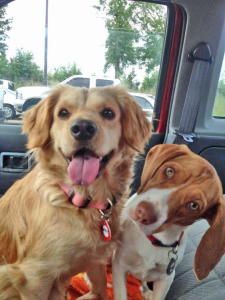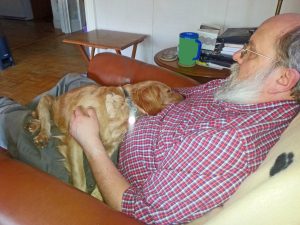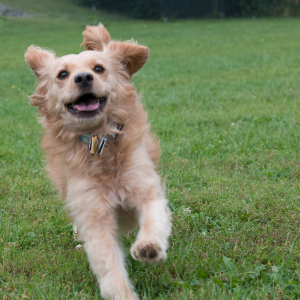If Yes, Then Please Join Me and Take the Pledge
< A version of this article was published in the October 2017 issue of Downeast Dog News>
 Dogs were first referred to as “Man’s best friend” in 1789 by Frederick, King of Prussia. Today it is not uncommon for a person to say that they consider their dog to not only be their friend but to be a member of their family. That is how I view both my dog and cats. In spite of this apparent devotion to dogs, there are still too many people in this country that routinely use electronic shock collars to subject their dogs to shock on a regular basis, all in the name of training and containment.
Dogs were first referred to as “Man’s best friend” in 1789 by Frederick, King of Prussia. Today it is not uncommon for a person to say that they consider their dog to not only be their friend but to be a member of their family. That is how I view both my dog and cats. In spite of this apparent devotion to dogs, there are still too many people in this country that routinely use electronic shock collars to subject their dogs to shock on a regular basis, all in the name of training and containment.
When a dog receives an electric shock from a shock collar, the shock is meant to be sufficiently aversive to change the dog’s behavior. An aversive typically causes either physical or emotional pain or both. If the dog does not find the shock aversive, the shock will not stop the behavior. That is basic psychology. Rewarding a dog for a behavior causes that behavior to increase, and punishing a dog or adding an aversive, causes a behavior to decrease. Those that insist the shock does not hurt the dog and that it is merely a “stim” or “tickle” are either misleading people or do not understand the fundamentals of psychology and learning theory.
What makes the use of electric shock on animals even more distressing than the fact that we are intentionally hurting our pets, is that science has demonstrated that the use of punishment is unnecessary to train or manage a pet. In fact, we know with certainty, that the use of shock and other aversives can be extremely detrimental. The use of aversives can damage the bond we have with our pet, impair our pet’s ability to learn, and often cause fear and aggression. Considering that shock is unnecessary, its use amounts to nothing less than abuse. So I ask, why would anyone intentionally abuse their best friend or a family member?
Since its beginnings in 2012, The Pet Professional Guild (PPG) has advocated against the use of aversives in the training and management of pets. In 2015, the American Animal Hospital Association (AAHA), an accreditation body for veterinary practices and hospitals, issued their Behavior Management Guidelines. The guidelines clearly state: “Aversive techniques include prong (pinch) or choke collars, cattle prods, alpha rolls, dominance downs, electronic shock collars, lunge whips, starving or withholding food, entrapment, and beating. None of those tools and methods should be used to either teach or alter behavior.” [Emphasis added]. The experts on our pets health, behavior, and training agree; shock should NEVER be used.
Whether the use of electric shock is intentional, due to casual disregard because “it is just a dog,” or due to ignorance, I and many others believe it is time for this inhumane treatment of our best friends and family members to stop. On September 25th the Pet Professional Guild (PPG) launched the Shock-Free Coalition ( http://www.shockfree.org ) “…an initiative that aims to build an international movement committed to eliminating shock devices once and for all in  the care, training and management of pets.” This noble cause is long overdue and one that I support without hesitation. I hope that you will join me in this movement to educate and advocate for the abolishment of the use of shock devices for the management and training of our best friends and family members. Please take the first step, and join me by taking the pledge at http://www.petprofessionalguild.com/Sign-The-Pledge.
the care, training and management of pets.” This noble cause is long overdue and one that I support without hesitation. I hope that you will join me in this movement to educate and advocate for the abolishment of the use of shock devices for the management and training of our best friends and family members. Please take the first step, and join me by taking the pledge at http://www.petprofessionalguild.com/Sign-The-Pledge.
What else can you do to support the Shock-Free Coalition?
- Dog Parents – Ask any and every pet care provider that participates in the care of your dog (animal shelters, boarding kennels, breeders, daycares, dog walkers, groomers, humane societies, pet related periodicals, pet sitters, places you buy pet food and supplies, rescues. Veterinarians, ) if they are aware of the Shock-Free Coalition and if they have taken the pledge. Encourage them to do so. If they chose not to take the pledge, ask them why. Suggest that they do some research and reconsider. You might even provide them with a copy of this column. If they are still unwilling to take the pledge, remember, you can choose who gets your pet related business. Sometimes money speaks louder than words.
- Pet Care Professionals – Take the pledge and make your support known to your employees, customers, and clients. Tell them about the pledge and ask them to take it as well. Show your support for the Shock-Free Coalition with signs in your facility, articles in your newsletter, information on your website, and with posts on social media. I know that pet parents care about this issue and they want to know that you care too!
- Dog Parents and Pet Care Professionals in Maine – It is my goal to place an ad in the November issue of Down East Dog News listing everyone one in the state of Maine who has taken the pledge. We need to show that those that still recommend and sell shock collars are a minority. We need to show them that we want to stop the unnecessary abuse of our pets. To make that ad happen, I need your help and some donations. Learn how to add your name to the list for the November ad and to make a donation at http://bit.ly/Shock-FreeME
To learn more about the problems with shock collars, visit these resources:
The Unintended Consequences of Shock Collar – http://bit.ly/ShockCollars
PPG Shock-Free Coalition – http://www.shockfree.org
Shock-Free Maine Information and Donation page – http://bit.ly/Shock-FreeME
PPG Guiding Principles – https://www.petprofessionalguild.com/PPGs-Guiding-Principles
Green Acres Kennel Shop Position Statement on Pet-Friendly, Force-Free Pet Care – http://blog.greenacreskennel.com/2006/02/01/no-pain-no-force-no-fear-green-acres-kennel-shop-position-statement-on-pet-friendly-force-free-pet-care/
AAHA Canine and Feline Behavior Management Guidelines – https://www.aaha.org/professional/resources/behavior_management_guidelines.aspx
________________________________________________________________________
Don Hanson is the co-owner of the Green Acres Kennel Shop ( greenacreskennel.com ) in Bangor. He is a Bach Foundation Registered Animal Practitioner (BFRAP), Certified Dog Behavior Consultant (CDBC), Associate Certified Cat Behavior Consultant (ACCBC) and a Certified Professional Dog Trainer (CPDT-KA). He produces and co- hosts a weekly radio show and podcast, The Woof Meow Show heard on The Pulse AM620 WZON and streamed at http://www.wzonradio.com/ every Saturday at 9 AM. A list of upcoming shows and podcasts of past shows can be found at www.woofmeowshow.com. Don also writes about pets at his blog: www.words-woofs-meows.com. He is committed to pet care and pet training that is free of pain, force, and fear. The opinions in this post are those of Don Hanson.
©1OCT17, Donald J. Hanson, All Rights Reserved
< Click for Copyright and Use Policy >





